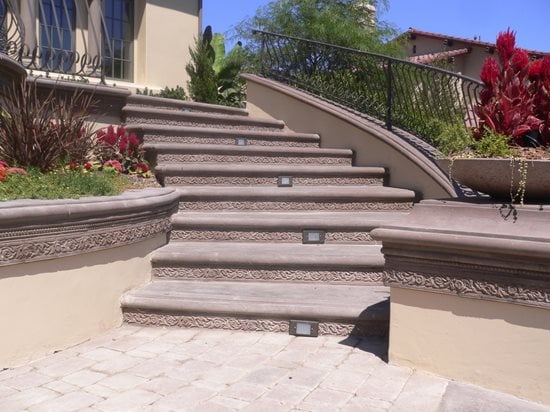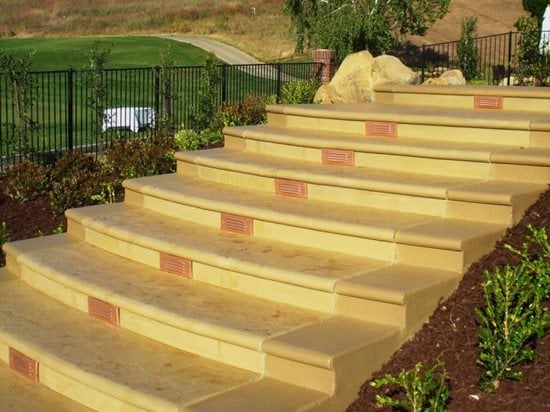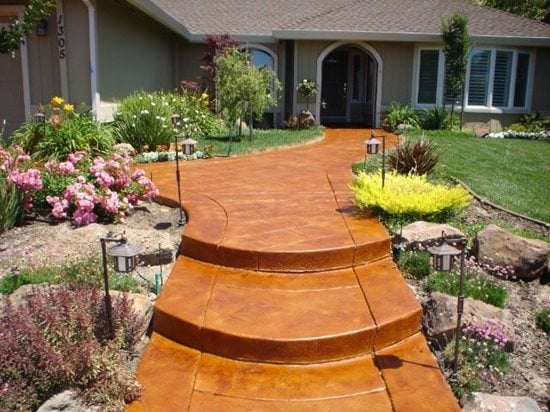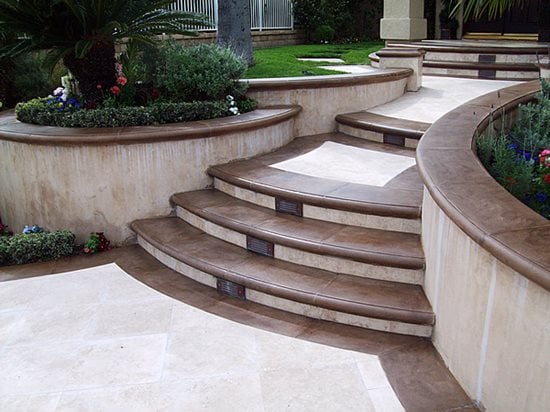- Concrete Walkways and Sidewalks
- Concrete Walkway Pictures
- Decorative Finishes for Existing Walkways
- Fix and Color Existing Concrete Walkways
- Sidewalk Repair - Resurfacing Concrete Walkways
- Design Ideas for Concrete Walkways
- 10 Ideas for Concrete Entryways
- Stairs and Steps
- Stamped Concrete Walkways
- Concrete Garden Bridges
- Front Porch Designs and Ideas
- Installing and Maintaining Concrete Walkways
- Concrete Walkway Cost
- DIY Concrete Sidewalk
- Building Tips for Concrete Sidewalks & Walkways
- Sealing and Protecting Walkways & Sidewalks
- Sidewalk Pavers
- Other Resources
- Concrete Contractors: Find Products and Suppliers
How to Add Lighting to Concrete Steps
Here’s a look at the various concrete step lighting options and how to choose the best system for your situation and budget.If you’re planning to have new concrete steps installed outside your home, an important factor to consider is their safety at night. To prevent dangerous stumbles, entryways should be well lit, and that often means installing more than one dim light fixture above the front door.
A great solution is to cast built-in light fixtures right in the concrete step risers at the time of construction. In addition to preventing potential injury, outdoor step lighting adds beautiful nighttime ambiance that will truly make your home stand out after dark.
Find concrete step contractors near me.
How are concrete step lights installed?
Concrete step lights fit right into the stair risers and focus light downward onto the step below it to offer enough light for safety without being distracting. Because the lights are set into the steps, the conduit raceways and the knockouts for the fixtures are installed inside the step forms before the concrete is poured. After the concrete cures, the knockouts are removed so you can connect the fixtures to the preinstalled electrical wiring.
Watch this short video from DecoCrete Supply to see an overview of the installation process.
Do I need to place lights on every step?
It’s generally not necessary to place lights on every step because this can cause the lighting to be overly bright. However, you also don’t want too many steps between lights because you’ll end up with areas that are poorly lit. The best arrangement is to install fixtures on alternating steps, which will give you enough coverage to prevent dark spots.

Placing lights on alternating steps will give you sufficient coverage to prevent dark spots without being too distracting. The Green Scene in Chatsworth, CA.
When positioning your lights, you should also consider the width of your steps. On wider steps, you may need to install more than one light fixture, spacing them approximately 3 to 4 feet apart, to provide the optimal amount of light for safety. Be sure to discuss light placement with your concrete contractor before the steps are poured because it will be very difficult to add or remove lights later.
What are my light fixture options?
There are numerous styles and shapes of concrete step lights. Choosing the best one for your needs often depends on what lighting effects you are trying to achieve and your budget.

Brass concrete step lights with louvered face plates offer the advantages of long-term durability and glare-free illumination. Staintec in Rancho Cucamonga, CA.
A key factor to consider is the material the fixture is made of because that can have a major impact on its life span and durability. Step lights made of plastic or aluminum tend to be the most affordable but are more easily damaged and can discolor or corrode after time. If you want something that lasts and will still look great after years of weather exposure, the best materials are bronze or brass. No matter what style of fixture you choose, make sure it has frosted glass, a louvered face plate, or downward-projecting lights so you can illuminate each stair tread without glare.
Another factor to consider is the type of bulb the light uses. Most outdoor lighting fixtures today use LEDs (light-emitting diodes) instead of traditional incandescent or halogen bulbs because they last longer and use substantially less energy. LED outdoor lighting is also available in several color temperatures, ranging from very warm white to cool white, allowing you to achieve different moods and brightness levels.
What is the best power source for concrete step lights?
Although you can use line voltage for your concrete step lighting (the basic 120-volt power supplied by your home's electrical outlets), the safest option is to use low-voltage cabling, which operates on only 12 volts of power, converted using a transformer. The low voltage is not only more energy efficient, it also eliminates the risk of accidental electrical shock.
How do I light an existing concrete stairway?
Although adding lights to existing concrete steps is possible, it can be challenging and expensive to bore holes into the concrete to retrofit the wiring and light fixtures. Instead of embedded light fixtures, a more practical approach is to install solar-powered LED lights to the stair treads or faces or pathway lighting alongside the steps themselves.
Solar-powered LED lights can typically be mounted to concrete steps using masonry screws or double-sided tape and offer the advantage of not requiring wiring or electrical lines. Although they are easy to install, the lights must be positioned in a spot where the solar panels will receive at least several hours of bright sunlight each day. On cloudy days and during the shorter days of winter, the duration and brightness of light will be limited. If you want more reliable illumination, you’re better off lighting your concrete steps with hard-wired fixtures.

Pathway lights are a great way to light an existing concrete stairway and can be powered by low-voltage wiring so you are assured of the lights coming on every evening. Coating Pro Inc in Loomis, CA.
Pathway lights can be installed in the ground on either side of your concrete stairway and can be powered by low-voltage wiring so you are assured of the lights coming on every evening (although solar-powered pathway lights are also available). To light your stairway evenly, alternate the placement of the light fixtures from one side of the step to the other. This will provide enough illumination to prevent tripping hazards while creating distinct pools of light that guide the eye naturally.
RELATED:
10 Front Entrance Ideas





